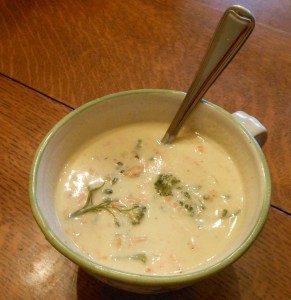Beans
Both string/wax beans like cucumbers, always have a “reserved section” in the vegetable garden. They are relatively easy to grow, if handled right are big producers and beans are able to be eaten fresh, added to recipes, cooked as stand-alone main or side dishes. They can be blanched and frozen and they even store well as pickles (dilly beans). Beans figure prominently in my ultimate quest to grow enough food –GMO and pesticide free – to provide a year round supply.
This year I planted 3 seven foot rows of bush beans for 2015. I chose 1 type to plant. It was a bush bean from Burpee called Garden Bean Stringless Green Pod. The Advertising for these beans states: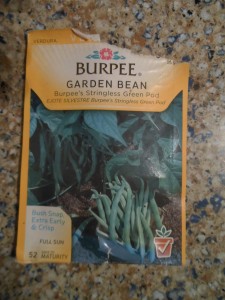
Exceptional flavor.
HEIRLOOM. This Burpee bred bean is entirely stringless; it’s brittle, meaty, juicy and has exceptional flavor. Plant yields are early and extremely high; pods are round, about 6″ long and slightly curved. Plants are entirely self supporting. A 2 oz. seed pack will plant a 20 ft. row. Our seed is not treated.
Growth Habit: Bush
Days to Maturity: 50 days
Sun: Full Sun
Height: 12-18 inches
Spread: 10 inches
Thinning: 6 inches
Sowing Method: Direct Sow
Fruit Size: 6 inches
They are spot on when describing flavor and the fact the pods are stringless. I will say all seeds germinated, the plants lasted all season, although I should have cropped and did a second planting in August.
We had a really bad season in 2015, weather and animal damage was the “order of the day”. First up was some animal was making short work of any bean plant near the edge of the garden. Leaves were eaten off and many times even the plant was chewed down. My guess is a rabbit since they are very common although my neighbor harbors a woodchuck and gray squirrels are all over. Anyway, the outer edge plants suffered all year.
June 2015 weather in the Northeast was cold. None of my plants really did anything during the month except survive. When July rolled around and everything warmed up and the beans took off.
By Mid-July we grew enough for weekly side dishes. That continued through frost – mid-October. The weight count harvested on the 21 feet was 13 lbs. Nothing was canned or frozen. A 13 lb. harvest is lower what my books say is the average harvest (14 lbs.) for the amount planted, it is very low based on past experience. There are prior years where a 16-foot row of pole beans would provide for 2 side dishes each week and enough to can/freeze for weekly side dishes from November 1 – April 30 of the next year.
Next year I am going back to pole beans. I am going to try Fortex (a pole snap bean) produced and sold by Burpee.
Bean Types:
Snap beans – the most popular garden beans — include bush and pole varieties, which vary in shape, size, and color. Tender filet beans are a type of green snap bean with stringless, slender, delicate pods. They are grown just like other snap beans.
Shell beans – grow like snap beans, but the immature pods stay tender for only a few days as the plants hurry to produce mature seeds. They are very easy to dry.
Scarlet runner beans – produce clusters of red blossoms that attract hummingbirds and bumblebees. You can eat the young pods like snap beans, or let the pods dry and harvest the mature beans.
Lima beans – stand up to humid heat and heavy insect pressure, which makes them a fine bean for warm climates.
Planting Beans
Beans do best in a soil with a PH of 6.0 – 7.5. Beans benefit from fertile soil. Before planting add some well-rotted compost, peat moss or fresh top soil into the garden bed. Beans make most of the nitrogen they need. When growing beans in a new garden site, inoculating seeds with nitrogen-fixing bacteria before planting can help kick-start this process.
For bush beans, plant seedlings 6” apart and keep the rows about 2 feet wide. Pole beans should be plant at about 10” apart in rows at least 2 – 3 feet wide. Pole beans need poles to grow on. I place posts 6 feet high about 2 feet apart and use wide garden netting for the plants to climb up. Mature pole beans are heavy and can bring down your entire row. Make sure the poles are firmly anchored and strong. It is not a bad idea to use cross beams to create a strong “fence row”.
Bean seeds germinate best when soil temperatures range between 60 and 70 degrees Fahrenheit. In spring, sow seeds in fertile, well-worked soil starting on or after your last frost date. Some of the problems you may encounter are:
• Many times the seeds will just sit until the weather is just right – that early in spring the soil may not get to the optimum temperature.
• If the soil is too wet, the seeds may rot or the young plants may “damp-off” and die.
• If you are “blessed” with squirrels like I am, they will dig up the seeds and eat them.
If you are planting seeds directly into the garden, plant them about 1 ½” deep.
I like to start the seeds about 3 weeks before the last expected frost inside the house under grow lights. Keep the seeds warm. They should sprout in about 2 weeks. Empty the pots of any seeds that do not sprout, pull the seed and replant the pot with a new seed. Plants that come up deformed should just be discarded and the pot should be replanted with a new seed. The previous 2 comments are more for me, way too many times I attempt to “doctor” the plants – it rarely works and the effort is not worth it. I plant the young plants about 2 weeks after the last expected frost – weather permitting, which means if the seven-day forecast is for decent, dry weather.
I let pole beans grow the full season. For bush beans, you should make additional plantings at least 1 more time during the season. Again, because I do not grow 50+ feet of row, I start seeds in pots about 3 weeks before I replant. When the seedlings are big enough, pull out the older plants, throw down some 10-10-10 fertilizer, a touch of lime (if necessary), add a little compost and replant. You will be happy you did. Even though you are giving up about 2 weeks of fresh beans, the new plants will end up producing more than the older plants would have.
Harvesting and Storing Beans
First thing is first, according to James Underwood Crockett, bush beans should produce roughly ½ lb. per foot per planting (so 2 plantings will give you 1 lb. for each foot.) Pole beans are different; you should look for a minimum of 1 lb. per foot for the season up to 2 lbs. If you are lucky shell beans will produce about ¾ lb. to 1 lb. per foot.
Harvest snap beans when they are young and tender. If you let the bean pods mature the plant may stop producing or will produce much less. The plants can be damaged or worse if you are not careful when harvesting. I like to use scissors or I will hold the plant where it connects to the bean pod. Most bush beans will produce a second or third crop of beans after the first one is picked. Harvest pole beans at least twice a week to keep the plants productive. The mature beans of all snap bean varieties usually make good soup beans.
Allow shell beans to stay on the plants until the pods turn tan and the beans inside show good color and a hard, glossy surface. If damp weather sets in just when your beans should be drying, pull up the plants and hang them in a dry place until they are dry enough to shell and sort. Allow your shelled beans to dry at room temperature for two weeks before storing them in airtight containers. If you think insects might be present in your stored beans, keep them in the freezer.
Saving Bean Seeds
To save dry beans for replanting, select the largest, most perfect seeds from your stored beans. With snap beans, it is best to harvest beans at the season’s end since it will not interfere with the food harvest. Be patient, because snap bean varieties that have been bred to stay tender for a long time are often slow to develop mature seeds. Under good conditions, bean seeds will store for at least three years.
Preventing Bean Pests and Diseases
Mexican bean beetles sporting black spots often lay clusters of yellow eggs on leaves, which hatch into yellow larvae that rasp tissues from leaves. Handpick this pest in all life stages, and try spraying neem oil to control light infestations.
In upstate New York, Japanese beetles are the devil to beans. The best organic method to fight them is to use Japanese beetle traps. If you use pesticides, you will end up dealing with: when you can theoretically harvest and the damage done to non-target insects (bees).
Beans grown in sites that recently supported grasses are often sabotaged by night-feeding cutworms. Another reason I like to start indoors and plant 3 week old plants.
Several fungal and bacterial diseases cause dark spots and patches to form on bean leaves. To keep from spreading diseases among plants, avoid working in your bean patch when foliage is wet.
Bean Growing Tips
Extend your harvest of bush snap beans by planting them two or three times, with each sowing three weeks apart. In warm climates, make a sowing in late summer, about 10 weeks before your first fall frost is expected.
Grow more beans in less space by growing pole varieties, which produce more per square foot by making good use of vertical growing space.

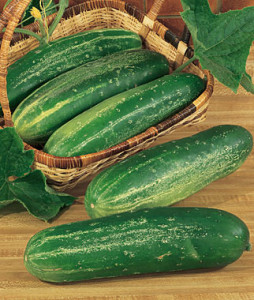
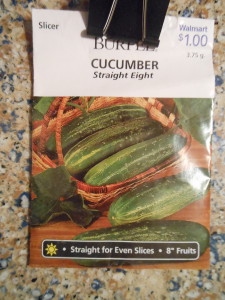
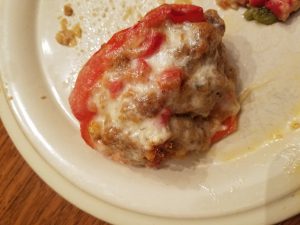 future use. We grow so many peppers that we need to always come up with new recipes. Another great feature is, other than cheese, this is a pure vegetarian meal – with the cost of meat that is great. If you have a garden, as we do, this is a great chance to make a meal from your hard work. You will also know how the vegetables were grown!! Try using red and yellow peppers for some extra color.
future use. We grow so many peppers that we need to always come up with new recipes. Another great feature is, other than cheese, this is a pure vegetarian meal – with the cost of meat that is great. If you have a garden, as we do, this is a great chance to make a meal from your hard work. You will also know how the vegetables were grown!! Try using red and yellow peppers for some extra color.